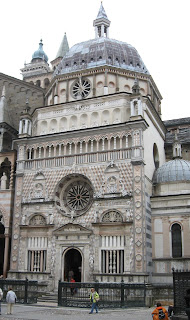The first time artillery played a major part in warfare
 |
| A portrait of Bartolomeo Colleoni |
On his side were infantry and cavalry representing Venice and on the other side there was an army serving Florence.
The occasion is now regarded as one of the most important events in Italian history as it was the first time artillery and firearms had been used extensively during a battle in Italy. Cannons with barrels up to 12 feet long would fire balls of metal or stone.
Leading the 14,000 soldiers fighting for Venice, Colleoni was working jointly with Ercole I d’Este from Ferrara and noblemen from Pesaro and Forlì.
Against Colleoni, another condottiero, Federico da Montefeltro, led an army of 13,000 soldiers serving Florence in an alliance with Galeazzo Maria Sforza, ruler of the Duchy of Milan, King Ferdinand II of Aragon and Giovanni II Bentivoglio, the ruler of Bologna.
Condottieri were essentially mercenaries, experienced military leaders who could be hired by Italy's city-states to organise and lead armies on their behalf.
The fighting took place between the villages of Riccardina and Molinella in Emilia-Romagna and the event is also sometimes referred to as the Battle of Riccardina.
It is not certain which side won, but as a result Colleoni abandoned his plans to conquer Milan. There were hundreds of casualties and a large number of horses were killed.
The following year Pope Paul II managed to broker a peace between the two sides.
 |
| Frescoes at Colleoni's Malpaga Castle show scenes from the Battle of Molinella |
The castle is open to the public at weekends between March and November.
As you walk round Bergamo you will see a chapel, a street, a bar and a restaurant named after Colleoni, who was a respected military leader who spent most of his life in the pay of the republic of Venice defending Bergamo against invaders.
He is remembered as one of the most honourable condottieri of his era, carrying out charitable works and agricultural improvements in Bergamo and the surrounding area when he was not involved in a military campaign.
He left money to Venice, with a request that an equestrian statue of himself be erected in Piazza San Marco. The statue was made by Andrea del Verrocchio, but as there was a rule that no monument was allowed in the main piazza, it was placed opposite the Scuola di San Marco in Campo Santi Giovanni e Paolo.
Towards the end of his life, Colleoni turned his attention to designing a building to house his own tomb in the Città Alta (upper town), which was to give Bergamo its most ornate and celebrated building, the Cappella Colleoni (Colleoni Chapel).
 |
| The Colleoni Chapel in Bergamo |
Amadeo designed the Cappella Colleoni to harmonise with Santa Maria Maggiore using pink and white marble to match the colours of the doorway of the basilica.
Inside the chapel he designed an elaborate two tier sarcophagus surmounted by a golden statue of Colleoni on horseback.
Colleoni died on 2 November, 1475 and his body was placed in the lower sarcophagus following his own instructions, where it still lies today.